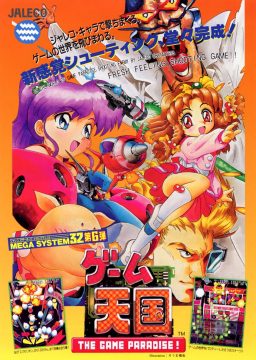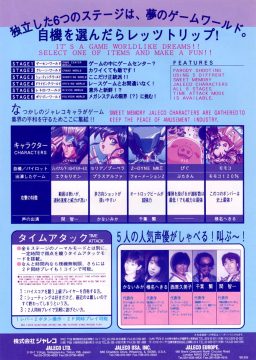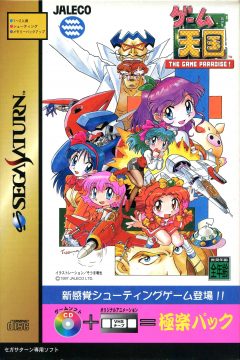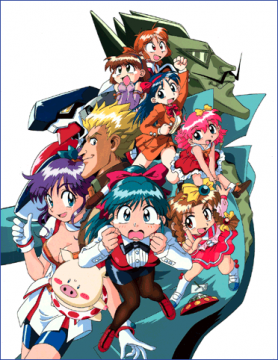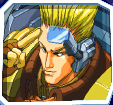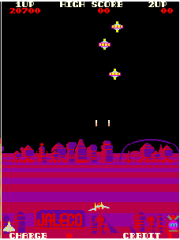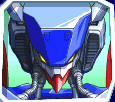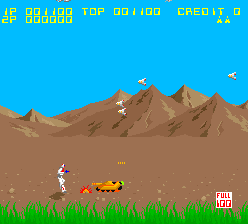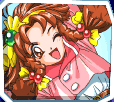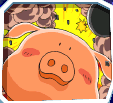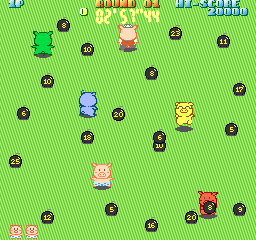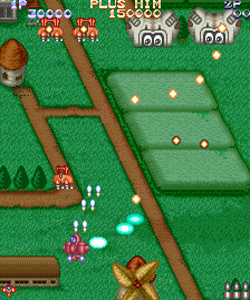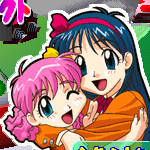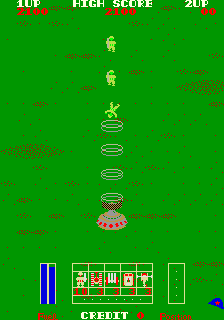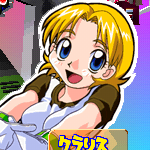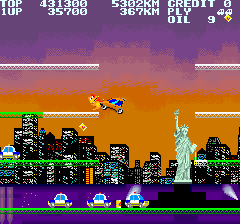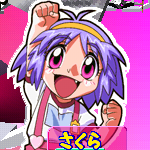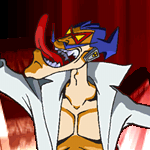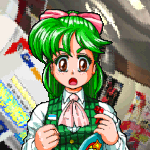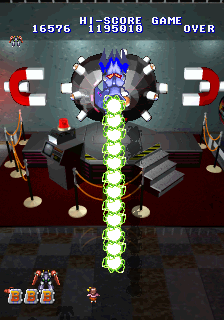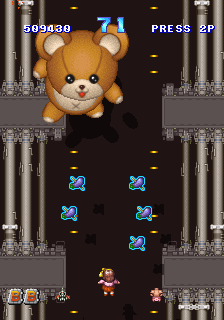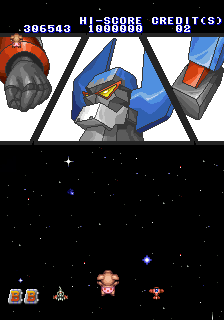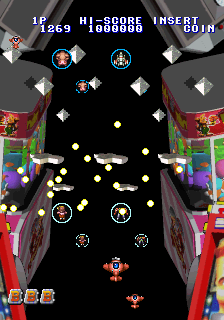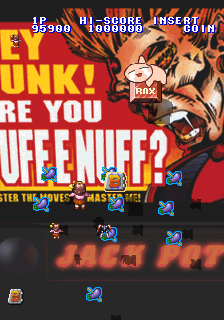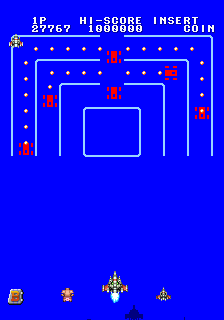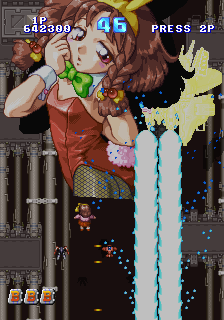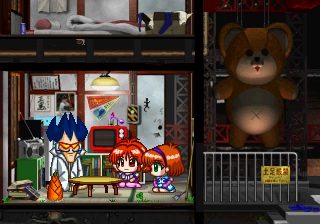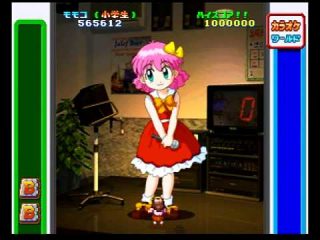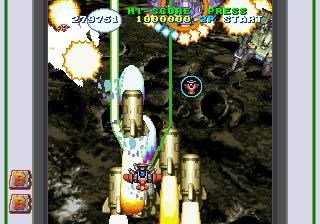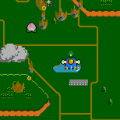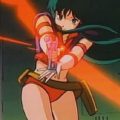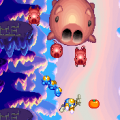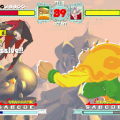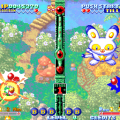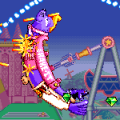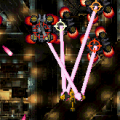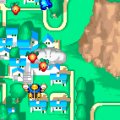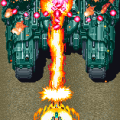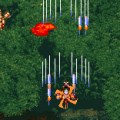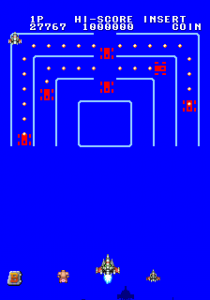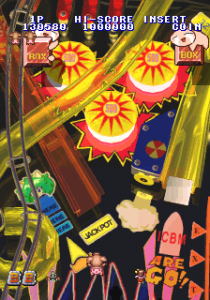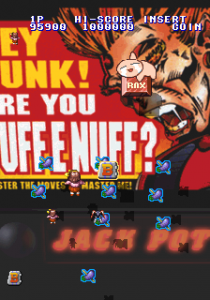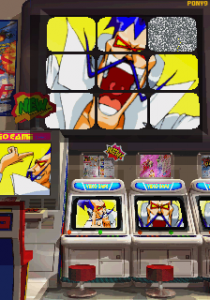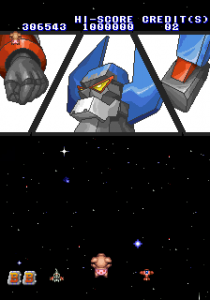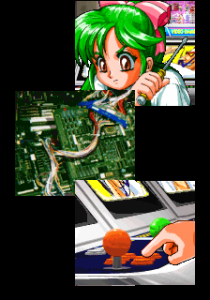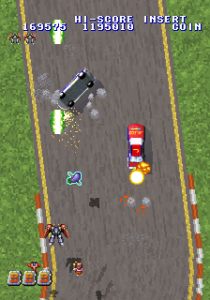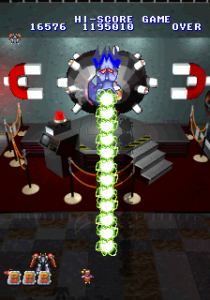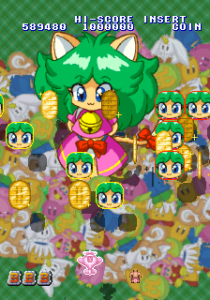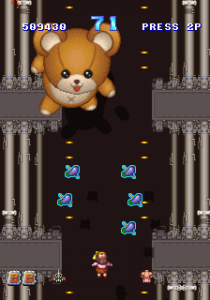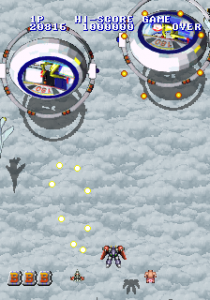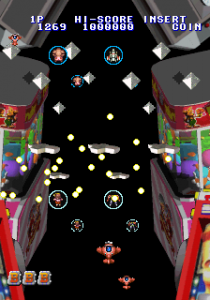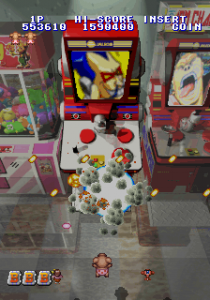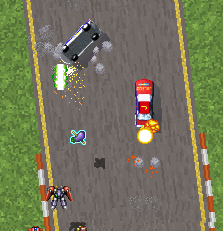- Game Tengoku – The Game Paradise!
- GUNbare! Game Tengoku – The Game Paradise 2
The Game Tengoku duo of games is to Jaleco what the Parodius series is to Konami – shoot-em-up featuring characters from their older games, with a bit of added silliness. Or that’s what everyone says. Actually it can be described as Japan’s Wreck-It Ralph before it even existed, being an affectionate parody of its mid-90s otaku/arcade culture set in several fictional games; at the same time, it is a product that panders to that very same demographic. How many other games you know included in their limited edition a videotape with a 16-minute original anime short plus lengthy interviews with the characters’ voice actors?
The first game plays similarly to some of Psikyo’s early vertical shooters: the controls have two buttons, one for shooting (keeping it pressed activates the charged shot) and one for deploying the smart bombs, whose explosions also cancel enemy bullets. The shot can be powered by picking up “P” icons which can be found, with bombs and attack options, in boxes held by floating super-deformed guys. The options are miniature versions of all the characters with their signature shots and they are given to us at the start of a stage and every time a life is lost. The scoring system is pretty simple as well: picking up several points items -eggplants, for some reason- in short order raises their value from 1000 up to 10000 points, plus some giant ones valued 48050 points (why?), and they are counted again at the end of a level, provided you didn’t lose a life before. Dying also only reduces your shot’s power by one rank.
This makes the game sound like an easy one for beginners, and it somewhat is. But after the first couple of stages, the enemy formations and bullet patterns force players to become more skillful, even if these never reach the heights of typical bullet hell shooters.
Jaleco, whose older characters come out of retirement to take part in this shooter, was not one of the most famous companies around, and some of their older properties are downright obscure in the West. Here’s a guide to all the important characters, including their voice actors, since they were one of the games’ main draws. Clicking on the character portraits shows their in-game cards when availablle.
Characters
Jeynus Starmine – Exerion (1983)
Voice: Tomokazu Seki
Your typical blond, handsome, square-jawed hero, Jeynus pilots the Fighter EX from one of Jaleco’s earlier efforts. Exerion is a top-down pseudo-3D vertical shooter that is notable for having both simulated inertia and parallax scrolling for backgrounds. The Fighter EX spaceship had two weapons, a slow double-shot cannon and a fast single-shot cannon with limited ammunition. Here it has just a straight-forward laser beam, even in charged “Lightning Blade” mode that shoots a huge laser. The smart bomb is an energy explosion that is not too big but lasts a while.
Z-DYNE Mk. II – Formation Z (1984)
Voice: Ryoutarou Okiayu
Formation Z or Aeroboto is a frustrating horizontal shooter where the player had to switch the mech’s form from robot to plane, a la Valkyrie from Macross/Robotech, in order to travel both on land and in air without consuming the plane form’s fuel. The second iteration of the mech (who apparently doesn’t transform anymore, being able to fly in his robot state) somehow gained intelligence and an English-speaking voice. Z-DYNE’s weapon of choice are green homing lasers which cover a decent area when charged, even more so as a bomb attack.
Momoko – Momoko 120% (1986)
Voice: Hekiru Shiina
Momoko doesn’t come from a shooter, but rather a weird run-n-gun where she shoots at strange creatures in burning buildings during various stages of life, from infancy to adulthood. Here she gains the ability to fly to compete with the other characters. To make otaku happy she is stuck in her pre-teen stage. Speaking of pandering, sometimes when she uses a smart bomb images of her in fetishized outfits (nurse, school gym uniform, bride, etc.) flash on screen. Her weapons, as befitting of her overly sweet design, are hearts and homing stars, with a ring of stars sweeping the screen from above as charged attack.
Pig – Butasan (1987)
Voice: Akio Ohtsuka
The proverbial flying pig wasn’t originally from a shmup. He comes from a curious top-down single screen action title (also known as Mr. Pig, Pig and Bombers and Psycho Pigs UXB) actually developed by NMK, where pigs of various colors throw timed cartoon bombs at one another. He’s portrayed as kind of a deep-voiced badass, but he has to be, since he works with explosives! Pig’s weapons in Game Tengoku are all bombs as well, which are slow but deal huge splash damage. The charged shot deploys a field of mines. His smart bomb makes a skull-shaped explosion in the sequel. Fun fact: in Game Tengoku 2 he has not one, but two secret alternate costumes complete with new dialogue lines.
Selia – Plus Alpha (1989)
Voice: Mika Kanai
This forgotten cute-em-up seems like Jaleco’s answer to Konami’s TwinBee, without the air-to-ground bombs. Selia is a cutesy blue-haired anime girl piloting a little biplane over a series of typical landscapes (valley, clouds, snow, desert…). Player 2 is Rumy, a short-haired blonde. All in all, an unremarkable title. Her appearance has been changed in Game Tengoku 2, again probably to pander to the 90s otaku’s tastes. Her weapon here is a spread shot that covers a vast space but is a bit weak unless charged; to compensate, her smart bomb (a flurry of beams and giant missiles) is one of the most powerful in the game.
Miki & Misato – Field Combat (1985)
Voice: Miki Takahashi and Satomi Koorogi
These two girls are original characters added to the Saturn port of the arcade. Their UFO-looking ship is the Genesis-3 from Field Combat, an arcade futuristic warfare vertical shmup, where the player not only can shoot at soldiers, tanks and helicopters, but also can call these units in action and capture enemy forces to turn them into other allies to deploy. Not sure what any of this has to do with a seemingly innocent schoolgirl that keeps her younger pink-haired sister on a leash (!!)… Anyway, the normal shot kind of sucks, because the enemies need to be inside the small target reticle to be damaged, but its real strength are two drones in the form of two soldiers, that relentlessy attack the enemies. Power-ups turn them into more powerful and deadly units such as helicopters. The charged shot is a damaging version of the capture beam from the original game.
Claris – City Connection (1985)
Voice: Konami Yoshida
Introduced in the PlayStation sequel, Claris (actually should be “Clarice”) comes from an arcade platform/puzzle game where one has to drive her car in order to paint all four tiers of a highway in stages set all around the world, because Jaleco already ran out of shoot-em-ups. She also looks nothing like her 1985 counterpart and nobody knows why. A flying car is almost quaint among the wackiness; it can shoot tires and oil cans, as another nod to the arcade game where she threw oil cans at police cars.
Sakura
Voice: Kae Araki
Momoko is absent from the sequel (but supposedly she can be unlocked as a secret character) and got replaced by her lilac-haired, even more loli-tastic little sister Sakura. Though in playing terms she’s the exact same character, having all the same weapons including the “fanservice bombs”. She never appeared in another game before, or since for that matter.
Genius Yamada
Voice: Shigeru Chiba
The bad guy, who somehow can travel through screens. He’s a freakishly tall middle-aged pervert mad scientist with a bizarre hairdo and the habit of being naked under his lab coat. Also, these mustache are apparently nose hair. As many other cartoonish villains, he’s fond of putting his sigil everywhere (his pair of triangular glasses, in this case). Has two young female assistants, Katou and Nakamura, who he talks with during the intermissions in the Saturn version of the game.
Yuki Ito
Voice: Kumiko Nishihara
The girl who works at the game center and gets attacked by Yamada. In the arcade game she only appears in the attract mode and when inputting your name in the score table (she herself writes it down). The sequel gives her a Playboy bunny uniform, just because.
Game Tengoku was originally an arcade game, set in an arcade and featuring several characters from old arcade games. The excuse plot is that a stereotyped mad scientist appeared one day in this center, and Yuki Ito, a cute green-haired girl who works there, enlists the help of various old Jaleco mascots to defeat him. Being game characters, they can travel through circuits and cabinets, but outside the first two stages of the first game (from the arcade interior to the crane game) it’s never actually shown how and where they jump from one cabinet to another. Still, all the areas are different kinds of games. Again, it’s difficult to label it as a true parody, since outside of some nods the stages are not mocking specific titles, and one of them, a generic space shooter, is played straight almost without a trace of comedy.
After inserting a credit, the game will ask you to play in Normal mode or Time Attack mode. The latter gives you endless lives and asks you to get in 160 seconds to the end of a generic stage with random enemies from all parts of the game (so that you fight a teddy bear right next to spaceships and Tetris blocks), and dying subtracts points from your total score.
The actual game starts inside the arcade (or game center, as the Japanese call it) over a field of coin-ops, that include some actual Jaleco titles; after having defeated a coin exchanger robot mid-boss, the players fly over a gigantic nuclear war-themed pinball… topped with Tuff E Nuff‘s infamous American SNES cover! The boss is a giant coin-op that turns into a mech. The second stage is set entirely inside a humongous crane game (or UFO Catcher, as the Japanese call it), based on an actual redemption machine, Wonder Hunting. All manners of toys and cutesy plushes attack us and there are Rodland dolls in the background. The boss is Rea-chan, an annoyingly sweet giant catgirl. Then the characters take part in a space shooter, which could pass for an actual, nondescript bullet hell shoot-em-up (or danmaku… enough with this) with dull spaceships and mechas, were it not for the boss which mocks old combining giant robot anime: the Yamada-bot that forms by putting together tons of random junk.
Stage four begins over a track from a racing game, with the cars being able to shot bullets, and a giant racing game cabinet on wheels as mid-boss. Then it becomes a generic military-themed shoot-em-up, ending with a magnet-powered gyroscope cabinet a la Sega’s R-360 played by the mad scientist, who every now and then pokes his head out and vomits at us! Stage five seems another generic space shoot-em-up, but the message “32-bit CPU captured by 8-bit CPU” appears and, sure enough, the enemies turn into low-res pixelated sprites. The enemies there pay homage to Space Invaders, Breakout and Sega’s Head On among others. The boss is a small pixel effigy of Genius Yamada’s face whose attacks are difficult to avoid. The sixth and last stage is a bit hard to describe: basically it starts with a series of wireframe polygons which are then textured and shaded, recycling several earlier sprites, with the enemies being random things like Nazca drawings and mannequins throwing each other (!?). Then our heroes briefly fly over a huge motherboard before fighting the final enemy: a giant holographic projection of the bad guy’s head. As a final mini-game, you can blow up the ending credits for points, until a second harder loop starts.
All in all, Game Tengoku does nothing in a groundbreaking way, but is still very competent and much better than the usual half-assed Jaleco fare. There are no slowdowns, the pace is just right and the characters’ abilities are varied enough to let anyone choose their favorite. Jaleco fans will be delighted by all the nods and references. The anime-styled graphics and character portraits are still good today, if maybe a bit garish because of the 90s taste, but the pre-rendered sprites (used for some bosses and the mechanical elements like cabinets and cars) haven’t aged too well. Then again, the last level seems to imply that the fake “plastic” look of the renders was intentional… but maybe they were just state-of-the-art in 1995. The background music is, for lack of a better term, “arcadey”, but completely forgettable, and the effects and voices drown it out. The characters are quite chatty (that’s the point of hiring famous voices), but the endless repetition of the same soundbites whenever you pick an eggplant would drive anyone crazy.
The Saturn port was released in June 1997 and contains several improvements thanks to the power of the CD format. First of all, players can choose between Arcade Mode and Arrange Mode: the latter one adds two exclusive stages that are more interesting, because the parody element is more focused. They make fun of other otaku pastimes such as karaoke, retrogaming and H-games. The first one is set in a pre-rendered tea room with a karaoke machine: Misato (the pink-haired girl) starts singing and the words of the song become actual obstacles to be destroyed.
Interestingly, to finish the level you have to shoot at the syllables to increase the karaoke machine’s counter and blow everything up (but Misato will be OK!), but if you do you won’t listen to the whole song; it doesn’t seem like much, but remember who the target audience of this title is. The second one is set inside a retrogaming shop like the ones in Akihabara: the players are assaulted by every kind of peripheral, including Virtual Boy knockoffs, before battling a home console mech. After defeating it they will be pulled inside a mahjong game called “Tokidoki Memory” (a dual parody, of Konami’s Tokimeki Memorial and Jaleco’s own Idol Fighter Suchie-Pai strip mahjong franchise), and then an old-school RPG unmistakably based on the first Dragon Quest game. The boss there is once again Genius Yamada, who plays the part of both the evil Dragonlord and the giant dragon he turns into! There’s also an additional boss fight at the end of the final stage.
Arrange Mode also contains a series of voiced cut-scenes between levels with super-deformed heroes and villains alike, for example Yamada discusses with his assistants in his run-down apartment how to stop the Jaleco guys and what weapons he will use next. They’re little more than a bunch of talking heads, but at least give some personality to the characters. The BGM also have been completely redone, but the original versions from the coin-op are no longer accessible. Another strange limitation is that Arrange Mode cannot be played in co-op and must be completed solo.
The Saturn version also gives the opportunity to choose between “yoko” and “tate” mode for the Arcade, provided that your television can handle it, otherwise you still can change the directional controls accordingly. Finally, there’s a collection of info about the old arcade games the protagonists come from and a nice view on Jaleco’s history, and the opportunity to rewatch the intermission scenes.

